Electronics News
Archive : 4 February 2015 год
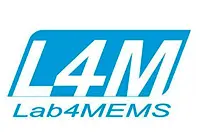 STMicroelectronics is to lead Lab4MEMS II, a €26million project which brings together 20 industrial, academic and research partners in nine European countries to focus on Micro Optoelectromechanical Systems (MOEMS).
STMicroelectronics is to lead Lab4MEMS II, a €26million project which brings together 20 industrial, academic and research partners in nine European countries to focus on Micro Optoelectromechanical Systems (MOEMS).
While the Lab4MEMS project focused on developing a pilot line for next generation MEMS devices augmented with such technologies as piezoelectric or magnetic materials and 3D packaging, Lab4MEMS II will integrate mechanical, optical and electrical systems to enable the sensing or manipulation of optical signals.
Roberto Zafalon, ST's European Programs Manager for R&D and Public Affairs, said: "MOEMS is a promising multi feature technology for the miniaturisation of critical optical systems that will benefit society, consortium members and stakeholders by creating valuable knowledge based employment opportunities, increasing long term prosperity and enabling products that benefit society."
The pilot line for Lab4MEMS II will be housed in ST's 200mm fab in Agrate Brianza, with optical technologies added to the mix. Meanwhile, the project will also evaluate the potential benefits and impact of a move to 300mm wafers.
Author
Graham Pitcher
Source: www.newelectronics.co.uk
 In a move which sees the separation of Plastic Logic's technology and manufacturing interests, FlexEnable has been launched with a mission to focus on 'truly flexible' electronics.
In a move which sees the separation of Plastic Logic's technology and manufacturing interests, FlexEnable has been launched with a mission to focus on 'truly flexible' electronics.
The move has been led by Indro Mukerjee, previously CEO of Plastic Logic. Mukerjee, who will be FlexEnable's chairman, said: "It's the launch based on Plastic Logic's existing set of IP and people and has been planned as a disruptive move." Meanwhile, the facility in Dresden which manufactures and sells electrophoretic displays will now be called Plastic Logic Germany.
According to Mukerjee, the company has been focused over the last two years on taking technology to a level of maturity more appropriate to wearable electronics. "One particular breakthrough," he claimed, "is to make a transistor array work with OLEDs; the most current dense application. Through changing the channel length of the transistor, it can now be used in OLEDs."
FlexEnable has three IP modules. FabEnable is intended to allow fabs to be built or upgraded to make flexible electronics. ProductEnable is targeted at those looking to create flexible electronics, while MaterialsEnable will help developers to assess and qualify materials for flexible electronics.
"FabEnable is a technology kit that will allow anyone to make flexible electronics," Mukerjee asserted. FlexEnable has also used its MaterialsEnable package to develop a graphene based display.
Mukerjee also noted the packages will allow companies to develop systems on plastic. "Designers will be able to link displays, sensors, logic and other elements on one piece of plastic as thin as a credit card."
The technology will enable products to be made on substrates as thin as 25nm which can be bent to a radius of as little as 0.25mm. "It will allow the creation of flexible and rollable displays," he contended.
Author
Graham Pitcher
Source: www.newelectronics.co.uk
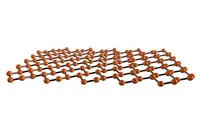 Researchers at The University of Texas at Austin have created the first transistors made of silicene. The research is said to hold the promise of building dramatically faster, smaller and more efficient computer chips.
Researchers at The University of Texas at Austin have created the first transistors made of silicene. The research is said to hold the promise of building dramatically faster, smaller and more efficient computer chips.
Silicene, made of a one atom thick layer of silicon atoms, is said to have outstanding electrical properties but has proved difficult to produce and work with.
Until a few years ago, silicene was a theoretical material. However, when they looked at graphene, researchers speculated that silicon atoms could be structured in a broadly similar way.
Deji Akinwande, an assistant professor at the university, said: "Apart from introducing a new player in the playground of 2D materials, silicene – with its close chemical affinity to silicon – suggests an opportunity in the road map of the semiconductor industry. The major breakthrough here is the efficient low-temperature manufacturing and fabrication of silicene devices for the first time."
Akinwande worked with Alessandro Molle at the Institute for Microelectronics and Microsystems in Agrate Brianza, Italy, to develop a method for fabricating silicene that reduced its exposure to air.
In the near term, Akinwande will continue to investigate new structures and methods for creating silicene, which may lead to low energy, high speed digital chips.
Author
Graham Pitcher
Source: www.newelectronics.co.uk
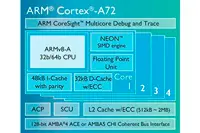 ARM has announced the ARM Cortex-A72 processor, said by the company to be the highest performing CPU technology currently available for developing mobile SoCs. The Cortex-A72 is anticipated to deliver a level of CPU performance that is 50 times greater than was available from the leading smartphones of five years ago.
ARM has announced the ARM Cortex-A72 processor, said by the company to be the highest performing CPU technology currently available for developing mobile SoCs. The Cortex-A72 is anticipated to deliver a level of CPU performance that is 50 times greater than was available from the leading smartphones of five years ago.
The A72 was announced as part of an IP suite that also includes a graphics upgrade that supports the display of 4K images at 120frame/s. Devices with this new industry-leading technology suite are expected to enter the market in 2016.
"Our new premium mobile experience IP suite with the Cortex-A72 processor delivers a decisive step forward from the compelling user experiences provided by this year's Cortex-A57 based devices," said Pete Hutton, president of ARM's products groups. "For multiple generations, together with our partners, we have delivered the leading-edge of the premium mobile experience. Building on this, in 2016 the ARM ecosystem will deliver even slimmer, lighter, more immersive mobile devices that serve as your primary and only compute platform."
More than 10 partners, including HiSilicon, MediaTek and Rockchip, have licensed the Cortex-A72, which is based on the 64bit ARMv8-A architecture. The core will enable 'sustained operation' at 2.5GHz, working within the power budget of a mobile device, when manufactured on a 16nm FinFET process. ARM is also expecting a 75% reduction in energy consumption for the same level of performance when compared to 2014 devices.
Also launched as part of the IP suite is the CoreLink CCI-500 interconnect, the Mali-T880 GPU and the Mali-V550 video and Mali-DP550 display processors.
Author
Graham Pitcher
Source: www.newelectronics.co.uk
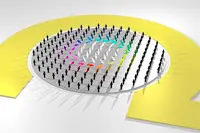 Skrymions – small magnetic whirls – may revolutionise future data storage and information processing if they can be moved rapidly and reliably in small structures, according to a European research team comprising scientists from Johannes Gutenberg University Mainz (JGU) and TU Berlin, together with colleagues from the Netherlands and Switzerland.
Skrymions – small magnetic whirls – may revolutionise future data storage and information processing if they can be moved rapidly and reliably in small structures, according to a European research team comprising scientists from Johannes Gutenberg University Mainz (JGU) and TU Berlin, together with colleagues from the Netherlands and Switzerland.
Skyrmions – small whirls in the magnetisation of magnetic materials – can have a diameter of less than 100nm. They may be important for the future of magnetic data storage and information processing if they can be moved rapidly and reliably along nanowires or other structures.
The researchers found skyrmions follow a complex trajectory and continue to move after external excitation is removed. The team say this effect will be especially important if a skyrmion is to be moved to a selected position, as would be necessary in a future memory device.
The skyrmions were prepared using small magnetic discs. "When we apply a specific external magnetic field, the magnetisation in these discs creates whirls," said Dr Benjamin Krüger from JGU. Skyrmions were then excited by a magnetic field pulse to trace their motion. "The measurements show that skyrmions move on a very complex trajectory – a hypocycloid," Dr Krüger added.
Because they move on such a curved trajectory means that they must possess inertia. "This effect has not been taken into account until now, but it is important for the development of small magnetic memories," explained Professor Mathias Kläui.
Author
Graham Pitcher
Source: www.newelectronics.co.uk
 Silicon Labs has bought Bluegiga Technologies in a cash deal which values the Finnish connectivity specialist at around $60million. According to Silicon Labs, the strategic acquisition expands its wireless hardware and software solutions for the IoT.
Silicon Labs has bought Bluegiga Technologies in a cash deal which values the Finnish connectivity specialist at around $60million. According to Silicon Labs, the strategic acquisition expands its wireless hardware and software solutions for the IoT.
"With Silicon Labs' wireless, microcontroller and sensor portfolios gaining considerable traction in the IoT markets, the timing of this acquisition couldn't be better," claimed Silicon Labs' CEO Tyson Tuttle. "Bluegiga's wireless modules and software stacks round out our wireless portfolio and complement our IoT solutions. The addition of Bluegiga wireless modules gives us new ways to deliver simplicity to our customers, enabling developers to easily add wireless connectivity to their designs."
Bluegiga develops Bluetooth and Wi-Fi modules, software stacks and development tools that are said to complement Silicon Labs' 802.15.4 ZigBee and Thread mesh networking software, along with its low power sub GHz solutions, and wireless MCU and transceiver products.
"The Bluegiga team is excited to join forces with Silicon Labs," said Riku Mettälä, Bluegiga's vice president of product creation. "Together, our wireless development teams will drive innovation in the IoT market, and our unified solutions will give customers a rich choice of wireless platforms for connected devices."
Silicon Labs will continue to use Bluegiga's Espoo base as a centre of excellence for wireless hardware and software technology development.
Author
Graham Pitcher
Source: www.newelectronics.co.uk
 A new way to process fibre optic signals has been demonstrated by UCL researchers, who claim the approach could double the distance over which data travels error-free through submarine cables. Because the new method does not require signals to be boosted, it has the potential to reduce the costs of long-distance optical fibre communications.
A new way to process fibre optic signals has been demonstrated by UCL researchers, who claim the approach could double the distance over which data travels error-free through submarine cables. Because the new method does not require signals to be boosted, it has the potential to reduce the costs of long-distance optical fibre communications.
The work, sponsored by EPSRC, addresses a new way of improving the transmission distance by undoing interactions between different optical channels as they travel over an optical cable.
Study author Dr Robert Maher said: "By eliminating the interactions between optical channels, we can double the distance signals can be transmitted error free from 3190km to 5890km – the largest increase ever reported for this system architecture.
"The challenge is to devise a technique to simultaneously capture a group of optical channels, known as a 'super channel', with a single receiver. This allows us to undo the distortion by sending the data channels back on a virtual digital journey at the same time."
The researchers used a '16QAM super channel', comprised of a set of frequencies which could be coded using amplitude, phase and frequency to create a high capacity optical signal. The super channel was then detected using a high speed super receiver and new signal processing techniques developed by the team enabled the reception of all the channels together and without error.
The researchers now plan to test the new method on the denser super-channels commonly used in digital cable TV (64QAM), cable modems (256QAM) and Ethernet connections (1024QAM).
Polina Bayvel, Professor of Optical Communications and Networks, added: "We're excited to report such an important finding that will improve fibre optic communications. Our method greatly improves the efficiency of transmission of data – almost doubling the transmission distances that can be achieved, with the potential to make significant savings over current state-of-the art commercial systems. One of the biggest global challenges we face is how to maintain communications with demand for the Internet booming – overcoming the capacity limits of optical fibres cables is a large part of solving that problem."
Author
Graham Pitcher
Source: www.newelectronics.co.uk
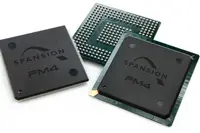 Looking to address emerging human machine interface applications, Spansion has added two ARM Cortex-M4 based MCUs to its product line. The FM4 S6E2DH features an integrated graphics display controller, while the S6E2CCxxF/MB9BF568F series comes with self contained voice command control.
Looking to address emerging human machine interface applications, Spansion has added two ARM Cortex-M4 based MCUs to its product line. The FM4 S6E2DH features an integrated graphics display controller, while the S6E2CCxxF/MB9BF568F series comes with self contained voice command control.
"These new product families deliver tremendous value and flexibility, enabling customers to design intuitive next generation human machine interface (HMI) systems," said Dhiraj Handa, general manager of Spansion's multimarket microcontroller business.
The S6E2DH series combines a Cortex-M4 core based MCU, a 2D rendering graphics display controller (GDC), dedicated video RAM and a mix of communication and digital peripherals. Also included are high speed interfaces for connecting to NAND and NOR flash and SDRAM.
The graphics subsystem features Spansion's HyperBus interface, allowing fast image retrieval without blocking code execution. The GDC comes with a low-level library for drawing and fast rendering of 2D shapes, in addition to several image processing features such as zoom, scale, rotate, mirror and move.
Running at 160MHz, the MCU comes with 384kbyte of flash, 36kbyte of SRAM and a 24 channel 2Msample/s 12bit A/D converter. The GDC supports WVGA displays at 8bit resolution using internal VRAM. Optionally, the device displays SVGA screens at 24bit resolution using external SDRAM.
Meanwhile, the S6E2CCxxF/MB9BF568F series enables voice command control. Featuring a Cortex-M4 running at up to 200MHz, the device's firmware can be updated over the air via Wi-Fi.
With up to 2Mbyte of dual bank flash, the part offers speaker independent voice control, with support for more than 100 commands.
Author
Graham Pitcher
Source: www.newelectronics.co.uk
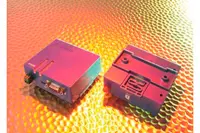 A dual band GSM/GPRS terminal from UK designer and manufacturer Siretta is said to set a new price point for such devices of less than £40. The cellular modem is intended to allow the deployment of wireless communications in M2M and IoT applications without the need for specialist wireless design skills, long design in cycles or complex wireless certifications.
A dual band GSM/GPRS terminal from UK designer and manufacturer Siretta is said to set a new price point for such devices of less than £40. The cellular modem is intended to allow the deployment of wireless communications in M2M and IoT applications without the need for specialist wireless design skills, long design in cycles or complex wireless certifications.
The modem, called ZEST, is said to provide complete, certified wireless connectivity for applications that need to communicate data via the cellular network.
"By pushing the price point to a new level, we have allowed many more applications to benefit from the reduction in development timescales, elimination of certification risk and improved total cost offered by modems," said Nick Lidington, Siretta's chairman. "Applications that struggled to justify the unit cost, such as automatic meter reading, remote vending machine management, LED signage and POS connectivity, will rapidly switch to terminal technology."
Supplied in a 75 x 84 x 31mm enclosure, ZEST can be wall or DIN rail mounted. It accepts a power supply from 6 to 18 V, and has an operating temperature range from -40 to 85°C.
The interface is an RS232 port, which allows software engineers to use either AT commands or Python script when developing applications. A 3G version of ZEST, to be launched shortly, will also feature a full USB interface.
Author
Graham Pitcher
Source: www.newelectronics.co.uk

